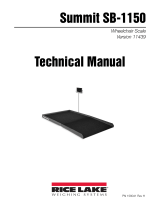
July 22, 2022 PN 214195 Rev A
Content subject to change without notice.
© Rice Lake Weighing Systems 230 W. Coleman St. •
Rice Lake, WI 54868
United States: 800-472-6703
International: +1 715-234-9171
3. Pairing Ai-1 Indicator with Wheel Weigh Pads
1. Press to turn on the Ai-1 indicator.
2. During startup, press the upper right corner of the
screen when the logo displays to enter the Technical
Setup menu.
Figure 9. Touch Upper Right Corner of the Display
3. Turn on the first wheel weigh pad only (assigned ID 01)
and allow to connect.
4. Wheel weigh pad connects with indicator and displays
PL.1.
5. Repeat Step 3 and Step 4 for additional wheel weigh
pads.
6. After wheel weigh pads are connected, press
.
7. If setup changed prompt displays. Press to
save settings.
Figure 10. Setup Changed
8. Indicator reboots to Weigh mode.
4. Initial Setup Parameters
The following parameter windows may display during initial
setup before the indicator reboots to Weigh mode.
• The Backup of the Configuration window — Press
to backup all settings
• The Password window displays — Press
or , depending on password requirements
• The Technical Setup window displays — Press
to convert the indicator units to match the
wheel weigh pad units
5. Applications
The Load Ranger wheel weigh pads can be arranged to serve
multiple applications. The adjustment from one scenario to
another is made quickly and easily with the wireless and
portability features of the Load Ranger system. This section
highlights several of the arrangements available.
5.1 Wireless Setup
A wireless system allows for weighing with up to 16
connected wheel weigh pads per Ai-1 indicator. The wireless
system is connected by following sections Section 1. through
Section 3.
Typically wireless setup is configured for 2, 3, 4,5 or 6 pads.
Two Platform Applications
Two platform applications include weighing axles of the
vehicle individually or trailers with only one axle.
Figure 11. Two Platform Application
Three Platform Applications
Three platform applications include weighing small planes,
three-wheeled vehicles or trailers with a support pin.
Figure 12. Three Platform Application
Four Platform Applications
Four platform applications include weighing two-axle
vehicles, trailers, containers or other items with four support
points.
Figure 13. Four Platform Application
Setup changed.
Save changes before restart the
indicator?
Technical setup
Cancel YesNo
The size and capacity of the third platform can
differ from those of the other platforms









